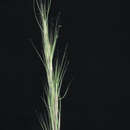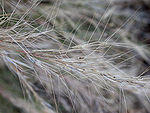More info for the terms:
cover,
forb,
forbs,
fuel,
grassland,
prescribed fire,
shrub,
succession,
wildfireFire reduced blue threeawn in a desert mountain shrub community near Big
Bend National Park, Texas. Wildfire burned the community in November,
1975. Prefire vegetation was dominated by sotol (Dasylirion
leiophyllum), lechuguilla (Agave lechuguilla), blue threeawn, and
sideoats grama (Bouteloua curtipendula). Precipitation was above average
in postfire years 1 and 2. At postfire year 2, blue threeawn cover on
burned plots averaged 0.42 percent while blue threeawn cover on adjacent
unburned plots averaged 4.09 percent. Grasses and succulents had
decreased at the expense of forbs and subshrubs. Forb and subshrub
cover on burned plots was 650 percent greater than on unburned plots
[
3].
Wright's and purple threeawn (Aristida purpurea var. purpurea) were
slightly to greatly reduced for at least two growing seasons following
chaining and burning in a redberry juniper (Juniperus erythro-
carpa)-mixed grassland community in King County, Texas. In 1979
or 1980, plots were chained, chained and broadcast burned in March, or
left untreated (control). Fine fuel loads averaged 2,264 lbs/acre
(2,573 kg/ha) in 1979 and 1,327 lbs/acre (1,508 kg/ha) in 1980. Weather
conditions were: relative humidity 25 to 40 percent, temperature 68 to
78 degrees Fahrenheit (20-26 deg C), and winds 7.7 to 14.4 miles/hour
(12-24 km/hr). Fire spread was "excellent" in both years, with nearly 100
percent coverage. Precipitation following the 1979 fire was above
average; drought followed the 1980 fire. Combined yield of Wright's and
purple threeawn was [
47]:
_________________________________________________________________________
| 1979 Treatments (wet year) | 1980 Treatments (dry year)|
|___________________________________________|___________________________|
| 1st growing 2nd growing | 1st growing 2nd growing|
| season season | season season |
|___________________________________________|___________________________|
|control 63a 63a* | 57a 25b |
|chained 92a 113a | 85a 37b |
|chained & burned 47a 56a | 12a 6b |
|_______________________________________________________________________|
*Values within a treatment year identified by the same letter are not
significantly different (p > 0.05).
Prescribed fire on the Texas Technological College Research Farm near
Amarillo had little effect on Fendler threeawn size but stimulated
seedstalk production. Six plots were used. Two plots were burned in
fall, 1965 (1 with and 1 against the wind); two plots were burned in
spring, 1966 (1 with and 1 against the wind); one plot was burned
summer, 1966 (with the wind); and one plot was not burned (control).
There were no significant differences in soil moisture between plots at
the time of the fall or spring fires. Basal diameters of Fendler
threeawn plants decreased between 1966 and 1967 on plots burned 2 years
in succession, but either maintained or increased in size on the
unburned control plot and plots burned only once the previous year.
Height and seedstalk production decreased between 1966 and 1967
regardless of treatment. Relative to the control plot, fire had little
effect on seedstalk numbers the first growing season after fire.
However, in the second growing season (1967), Fendler threeawn seedstalk
numbers were greater on all burned plots compared to the control plot.
Average seedstalk production and average maximum height of Fendler
threeawn was [
52]:
Number of Fendler Threeawn Seedstalks
|----------------------Treatment-------------------------|
|Control Fall Fall Spring Spring Summer|
Year | 1965 1965 & 66 1966 1966 & 67 1966 |
_______________|________________________________________________________|
1965* | 115 135 107 55 115 127 |
1966 | 40 105 82 25 67 37 |
1967 | 39 45 55 43 48 55 |
_______________|________________________________________________________|
*before burning
Height (cm)
|----------------------Treatment-------------------------|
|Control Fall Fall Spring Spring Summer|
Year | 1965 1965 & 66 1966 1966 & 67 1966 |
_______________|________________________________________________________|
1965* | 33 32 30 27 27 35 |
1966 | 25 23 20 20 20 20 |
1967 | 12 11 10 11 11 11 |
_______________|________________________________________________________|
*before burning
Fendler threeawn was reduced following wildfire in a cheatgrass stand in
north-central Utah. Vegetation had been sampled at the end of the 1955
growing season. The wildfire occurred in summer 1956. Precipitation in
1957 (the only year for which precipitation data are given) was near
average. Fendler threeawn cover and importance percentages were as
follows [
6]:
Year
----------------------------------------
1955 1957 1958 1960 1961
----------------------------------------
cover (%) 11.5 3.4 6.2 9.9 5.0
importance (%) 17.7 4.2 8.6 11.6 5.9


 Spikelets showing the characteristic three awns apiece
Spikelets showing the characteristic three awns apiece